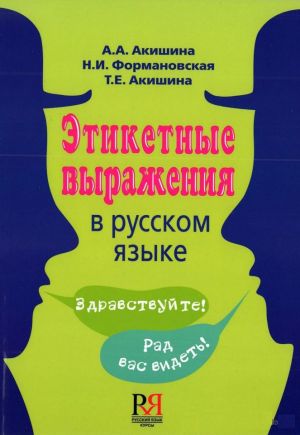Научить студентов-иностранцев общаься в самых разнообразных ситуациях, расширить арсенал языковых средств учащихся за счет стилистически окрашенных формул этикета, усовершенствовать их речевые умения и навыки восприятия спонтаннй русской речи - таковы цели многопланового учебного пособия-практикума. Особое внимание уделяется отграничению общеупотребительных клише от выражений, принятых преимущественно в официальной обстановке или в непринужденном общении, а также речевых формул, характерных для разных социальных и профессиональных групп носителей языка (молодежь, люди старшего возраста, представители научной, вузовской среды и т.д.).
Материал организован по темам (приветствие, знакомство, поздравление и т.д.); разнообразые творческие задания к каждой теме ориентированы главным образом на развитие спонтанной диалогической и монологической речи.
Пособие адресоввано иностранным студентам, изучающим русский язык на продвинутом этапе, может быть использовано преподавателями русского языка как иностранного.
Etiquette phrases in Russian.
The goal of the textbook is to teach foreign students to communicate in various situations, to enrich their vocabulary with the stylistically colored expressions of etiquette, to master their speaking and listening skills and habits of the spontaneous Russian speech. Special emphasis is laid on teaching the ability to differentiate between the general cliches and phraseological units used in the official and informal situations or speech units used by different social and professional groups of native speakers ( youth, elderly people, representatives of scientific or higher education media, etc).
The material is organized by topics ( greetings, getting acquainted, congratulations, etc). Each topic is provided with various creative assignments aimed at the development of the spontaneous dialogical speech and the monologues.
The manual is designed for advanced learners and teachers of Russian as a foreign language.
Etiketti-lausekkeita venäjäksi
The goal of the textbook is to teach foreign students to communicate in various situations, to enrich their vocabulary with the stylistically colored expressions of etiquette, to master their speaking and listening skills and habits of the spontaneous Russian speech. Special emphasis is laid on teaching the ability to differentiate between the general cliches and phraseological units used in the official and informal situations or speech units used by different social and professional groups of native speakers ( youth, elderly people, representatives of scientific or higher education media, etc).
The material is organized by topics ( greetings, getting acquainted, congratulations, etc). Each topic is provided with various creative assignments aimed at the development of the spontaneous dialogical speech and the monologues.
The manual is designed for advanced learners and teachers of Russian as a foreign language.
Nauchit studentov-inostrantsev obschasja v samykh raznoobraznykh situatsijakh, rasshirit arsenal jazykovykh sredstv uchaschikhsja za schet stilisticheski okrashennykh formul etiketa, usovershenstvovat ikh rechevye umenija i navyki vosprijatija spontannj russkoj rechi - takovy tseli mnogoplanovogo uchebnogo posobija-praktikuma. Osoboe vnimanie udeljaetsja otgranicheniju obscheupotrebitelnykh klishe ot vyrazhenij, prinjatykh preimuschestvenno v ofitsialnoj obstanovke ili v neprinuzhdennom obschenii, a takzhe rechevykh formul, kharakternykh dlja raznykh sotsialnykh i professionalnykh grupp nositelej jazyka (molodezh, ljudi starshego vozrasta, predstaviteli nauchnoj, vuzovskoj sredy i t.d.).
Material organizovan po temam (privetstvie, znakomstvo, pozdravlenie i t.d.); raznoobrazye tvorcheskie zadanija k kazhdoj teme orientirovany glavnym obrazom na razvitie spontannoj dialogicheskoj i monologicheskoj rechi.
Posobie adresovvano inostrannym studentam, izuchajuschim russkij jazyk na prodvinutom etape, mozhet byt ispolzovano prepodavateljami russkogo jazyka kak inostrannogo.













